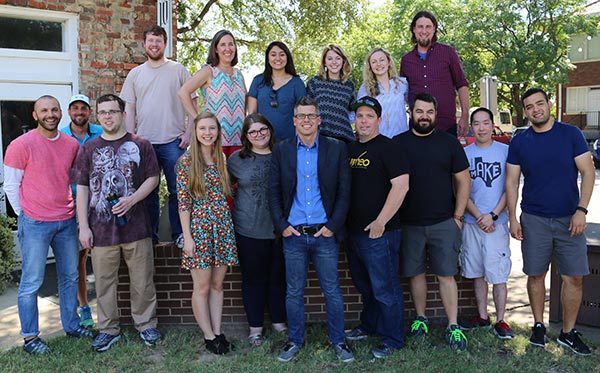Our company culture is anything but boring. It’s not uncommon to see me practicing an air golf swing or a door frame pull-up in the middle of a conversation. (It helps me concentrate.) Neither is it uncommon to see me wearing noise canceling headphones with my feet propped up working on a project in my office or for me to attend a client meeting wearing a sport jacket and flat-billed cap. These snapshots reflect on our company culture as a whole. Whether it’s a Facebook live video of our interoffice salsa eating competition or a spontaneous rap performance about how Santa runs the North Pole, our company culture reflects who I am as a person: predictable in my unpredictability.
Company culture makes a big difference to highly recruitable new hires. I want to be the company that has a waiting list of people who want to work with us because it means I get to work alongside the best people. Instead of settling for what other companies passed over, I can pick qualified people who fit within our culture. (We can train people and develop raw talent. It’s harder to train people to fit a culture. We opt for fit over talent.)
As an entrepreneur and a leader, you set the tone for the culture of your company. I want to make it a place where, if I were the employee, I would want to work.

Don’t take yourself too seriously
A sense of humor goes a long way toward creating an enjoyable environment. Self-deprecating humor shows your team that you don’t think of yourself as sitting up on a pedestal. (Chances are they’ll figure it out anyway.) Be approachable, welcome new ideas, laugh together about office antics (not at someone else’s expense), and be willing to look silly for a purpose.
Every year around Christmas our company does an ad campaign that puts everyone in the company on an even playing field. We’ve done everything from creating movie trailers to posing in ugly Christmas sweaters and filming cringe-worthy music videos. The past two years we’ve also competed together in the Savage Race as a bonding experience we can laugh about for years to come. It’s not mandatory, but we reimburse anyone who signs up and competes. It’s good exercise and gives us a common experience outside of the office. The pictures are priceless and, as another example of my predictable unpredictability, I may or may not have crowd surfed at the last race. (I’m consistent in my randomness, even outside the office.)

Minimize meetings and maximize engagement
Meetings are a necessary evil of doing business, but not every person has to attend every meeting. We meet as a company once a week (if that) for approximately 30 minutes. That’s it. Other meetings are either impromptu or only scheduled with the team members who absolutely have to be there for the project to move forward. This improves morale as well as productivity. At one meeting, we showed pictures and videos of the team competing in the Savage Race. Even the people who didn’t compete could share in some of the fun. During another meeting, we debuted the Christmas music videos.
Just because we don’t meet often doesn’t mean our leadership isn’t touching base with team members regularly. A quick visit at the desk to assess a task while asking how the weekend was or to ask if an employee saw the latest episode of a favorite television show (Ahem. American Ninja Warrior.) builds a relationship in short spurts without wasting time in unnecessary meetings. That rapport goes a long way when you have a big ask of that employee or when you need to address a point of conflict. Simply put, it creates a culture that emphasizes the value of relationship.

Trust your employees
Micro-management destroys motivation, productivity, and initiative. When you hire somebody to work for you, hire people you trust to do the job. If you’re going to end up doing it yourself, why bother hiring them? Aside from their initial training, you shouldn’t feel like you have to look over their shoulder all the time. Point out areas where they need improvement or provide additional training tools, but trust them to do what you hired them to do. If you don’t think you can trust them, maybe you shouldn’t hire them in the first place.
Praise in public and correct in private
When you’re pointing out areas that need improvement, don’t shame employees by calling them out in front of everybody else. Your motivation should be to see them grow as an individual (and in turn to grow their part of the company), not to humiliate or belittle them. True leaders don’t have a need to boost themselves up by making other people look (or feel) small. Any personal conflict you may have with someone should be addressed one-on-one rather than in a group environment.
However, when they do something great, praise them in public. Give out the kudos and attaboys when they’re deserved. Make a big deal about their victories because their victories are yours, too. Praising an employee in public encourages them by making them feel like a valuable member of the team and motivates other team members to do their best. Whether they admit it or not, everybody likes an attaboy.
Find reasons to celebrate
People like parties. Look for excuses to get together for a meal or happy hour to celebrate something together. Celebrate birthdays, product launches, new hires, or moving into a new location. You don’t have to buy a meal for everyone, but treating an employee on their birthday goes a long way toward making them feel appreciated. It’s not a merit-based award; it’s a gift for simply being born. If the company wins an award, celebrate as a team. For the record, all of our trophies and awards are in public locations around the office, not in my office.
Don’t allow toxicity to take hold
If you sense a toxic person or situation invading the company culture, address it head on before it has the opportunity to grow. Like cancer, a toxic situation is easier to remedy when it’s small than it is when it’s given time to grow. Toxicity can take the form of a negative employee, a difficult client, or a combination of the two. Address interoffice conflicts so they don’t have time to develop into a full-fledged office drama.

Set the tone
Remember that you set the tone. If you’re good natured, positive and exhibit a good work ethic, your company culture will be more likely to follow suit. On the other hand, if you’re a CEO with a chip on your shoulder who is always looking to take short cuts, your company culture will still follow suit. In other words, don’t expect the company culture to be something you’re not.
Be fun and get work done, but don’t be afraid to be predictably unpredictable. If you’re going to spend 40 plus hours each week doing something, you should enjoy it. So should the people you work with.
